Crop Production and Management | Chapter 21 | 8th Science - Basic Practices of Crop Production | 8th Science : Chapter 21 : Crop Production and Management
Chapter: 8th Science : Chapter 21 : Crop Production and Management
Basic Practices of Crop Production
Basic Practices of
Crop Production
Different activities in crop
production are ploughing, sowing, applying fertilizers, harvesting and seed
storage. All these activities collectively have an effect on the yield of
crops.
1. Soil preparation
The most important aspect in
agricultural process is to loosen the topsoil. The loosened soil helps in the
growth of earthworm and soil microbes. These organisms add humus to the soil
and are friendly to farmers. Plants absorb water, minerals, nutrients and air
from the soil through their roots. Hence it is essential to prepare the soil in
a proper way before starting the cultivation practice. The soil preparation
methods are given below.
a. Ploughing
Ploughing or tilling is the process
of loosening and turning the soil up and down to facilitate the availability of
nutrients in the root zone of the cultivating crop.
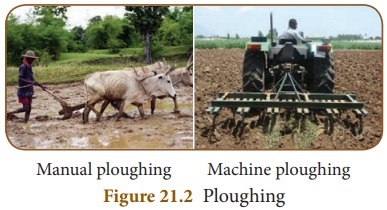
The following are the few important
agricultural implements generally used in the field preparation.

Plough
Plough is mainly used for tilling
the soil, to add fertilisers to the crop, remove weeds and other waste
materials from the field and also to turn the soil. A plough is made of wood
and is drawn by a pair of bulls or horses. It contains a strong and a sharp
triangular iron strip known as ploughshare. The main part of the plough is a
long log of wood which is called plough shaft. The other end is attached to a
beam which is placed on the bull’s neck.
Hoe
It is a simple tool which is used to
till the land, remove weeds and dig up soil. It has a long wooden rod with a
bent iron plate at one end. The other end may be attached to an animal.
Cultivator
Cultivators are driven by tractor.
Cultivators also kill weeds and dig up unwanted vegetation available in the
field. Nowadays ploughing is done by tractor-driven cultivator. The use of
cultivator saves labour and time.
b. Leveling
Once the field is ploughed, the
topsoil is quite loose. The levelling of soil is done with an implement called
the leveller, which is a heavy wooden or iron plank. Levelling of the field
also helps in uniform distribution of water during irrigation.
c. Basal Manuring
Manuring means adding manure to the
soil. Manure contains many nutrients required for the growth of crop plants. To
increase the fertility of the soil, we add manure to the soil even before
sowing because it gets properly incorporated into the soil. Application of
green manure and farmyard manure will always enhance the growth and yield of
the crops.
2. Sowing of Seeds
This is the second step in crop
production. Once the soil preparation is over, sowing of the seeds can be done.
Sowing is the actual process of planting the seeds in the soil. The seeds that
are sown have to be selected very carefully to have high quality. Various
methods are followed for sowing the seeds.
a. Sowing by hand
The scattering of seeds by hand is
the simplest method of sowing seeds. This is the most economical method of
sowing seed.
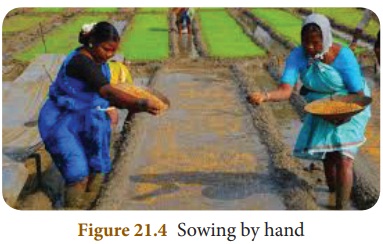
b. Seed Drill
Seed drill is a modern method of
sowing seeds. It is a better and more efficient method than sowing by hand. It
is usually done by attaching iron drills to a tractor. Seed drills ensure that
the seeds are planted at equal intervals and at the correct depth in the soil.
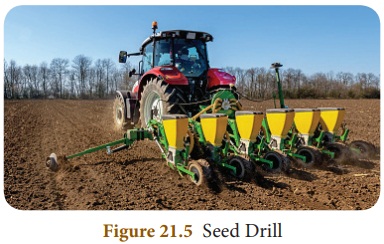
c. Dibbling
It is the placement of seed material
in a furrow, pit or hole at predetermined spacing with a dibble, more commonly
by hand. Soil around the hole is pressed with hand or leg for moist soil
contact.
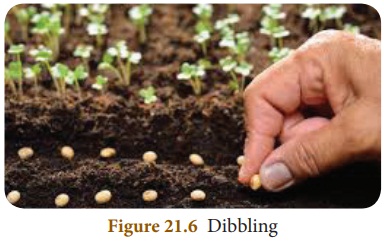
More to know
Transplanting is
removal of an actively growing seedling from one place (usually nursery bed) and
planting it in the main field for further growth till harvest. Transplanting
makes use of pre-grown plants, seedlings or vegetative propagated clones.
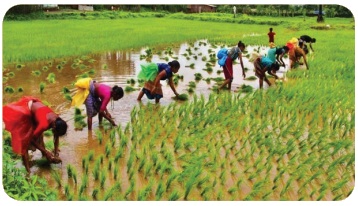
3. Adding Manure and
Fertilisers
The substances which are added to
the soil in the form of nutrients to enhance the growth of plants are called manure and fertilisers. The term fertility refers to the inherent capacity of
a soil to supply nutrients to crop plants in adequate amounts and in suitable
proportions. These nutrients are essential for the growth of plants.
Manure is an organic substance
obtained from the decomposition of plants or animal wastes. Farmers dump plant
and animal waste in pits at open places and allow it to decompose. The
decomposed matter is used as organic manure. Regular addition of organic
manures helps to maintain the soil fertility, protecting them from wind and
water erosion and preventing nutrient losses through runoff and leaching. This
also increases water-holding capacity, soil aggregation, soil aeration and
permeability.
Activity 2
Set up a compost pit
within your school compound. Put all the organic wastes like food waste and
plant leaf in your school campus, cover it with soil. Wait for three weeks and
then you can use this as manure for the plants in your school.
Fertilizer is a substance which is
added to the soil to improve plants’ growth and yield. Fertilizers are composed
mainly of Urea, Ammonium sulphate, Super phosphate, Potash and NPK (Nitrogen,
Phosphorus, Potassium). The use of synthetic fertilizers has significantly
improved the quantity of the food available today, although their long-term use
is debated by environmentalists.
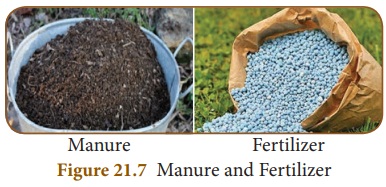
4. Irrigation
Water is important for the proper
growth and development of plants. Plants absorb water from their surrounding
with the help of the root system. The supply of water to crops at regular
intervals is called irrigation . The
time and frequency of irrigation varies from crop to crop, soil to soil and
season to season. Fertilizers can also be applied through the irrigation. The
various sources of irrigation are wells, tube wells, ponds, lakes, rivers, dams
and canal. Effective irrigation is the controlled and uniform supply of water
to crops, in the required amount at the right time with the minimum
expenditure. Irrigation can be carried out by two different methods.
a. Traditional Methods
b. Modern Methods
a. Traditional Methods
In these methods, irrigation is done
manually. Here, a farmer pulls out water from wells or canals by himself or
using cattle and carries to farming fields. Pumps are also commonly used for
lifting water from various sources. Diesel, biogas, electricity and solar
energy are the few important sources of energy needed to run these pumps. The
method of pulling water may vary from one place to other place.
Activity 3
Find out the
irrigation system followed in your area. Also, debate on the advantages and
disadvantages of modern irrigation systems like sprinkler system and drip
system.
The main advantage of this method is
that it is cheaper. But its efficiency is poor because of the uneven
distribution of water. It also leads to heavy water loss.
b. Modern Methods
The modern irrigation methods help
to overcome the problems exist in the traditional methods. It also facilitates
the even distribution of moisture in the field.
The modern methods involve two
systems. They are:
* Sprinkler system
* Drip system
Sprinkler
System
A sprinkler system sprinkles water
over the crop and helps in an even distribution of water. This method is much
advisable in areas facing water scarcity. Here a pump which generates pressure
is connected to pipes, and water is sprinkled through the fine nozzles of
pipes.
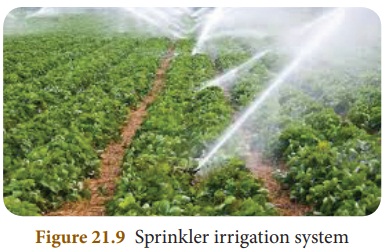
Drip
System
In drip system, water is released drop
by drop exactly at the root zone using a hose or pipe.

This method is considered as the
effective one in regions where the availability of water is less.
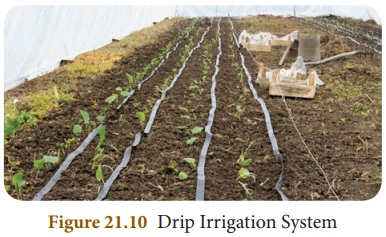
The global population
is expected to be 9 billion by the year 2050. But, agriculture activities alone
utilize 70% of the availablefresh water resources. So, efficient and
sustainable water use is needed for our own generation and future generations.
Drip irrigation is a better solution for economical use of water.
5. Weeding
In an agriculture field, many other
undesirable plants may grow naturally along with the main crop. These
undesirable plants are called weeds.
The removal of weeds is called weeding. Weeding is an important process because
weeds compete with the crop plants for the nutrients, sunlight, water, space
and other resources. It results in the under nourishment of crops and leads to
low yield. It is mandatory to remove seeds from the field to achieve the
expected yield. Farmers adopt many ways to remove weeds and control their growth.
Some of them are explained below.
Mechanical
methods
This is the most common method in
which weeds are destroyed physically. Hand pulling or weeding with the help of
weeding hoe is the oldest and most efficient method for controlling weeds.
Tillage
methods
It is one of the practical methods
of destroying weeds of all categories. Weeds are buried in the soil and also
exposed to sun heat by deep ploughing.
Crop
rotation
In this method, proper rotation of
crops is followed for controlling crop associated and parasitic weeds.
Summer
tillage
Deep ploughing after harvest of rabi
crop and exposing underground parts of weeds to strong sunlight during summer
months is useful for destroying many annual and perennial weeds.
Biological
weed control
In this method, bio agents like
insects and pathogens are used to control weeds. The objectives of biological
control are not eradication, but reduction and regulation of the weed
population.
Chemical
methods
Chemical methods are very effective
in certain cases and have great scope in weed control. The chemicals used for
killing the weeds or inhibiting their growth are called herbicides. These chemicals are mixed with water and sprayed over
the crops.

There are over 30000
species of weeds around the world. Out of these 18000 species cause serious
losses to crops. The continuous useof the same method leads to building up of
tolerant species. Therefore, a suitable combination of different methods of
weed control should be practiced.
Integrated
weed management
Integrated weed management combines
different agronomic practices and herbicides use to manage weeds, so that the
reliance on any one weed control technique is reduced. Mechanical, biological,
cultural and chemical methods are included in integrated weed managements.
6. Harvesting of Crops
The process of cutting and gathering
a crop is called harvesting.
Different methods are used for harvesting.
Manual
harvesting
This is the major method of
harvesting in India. Certain crops are harvested without using tools. Crops
like ground nut, green gram, black gram and horse gram can be harvested by
uprooting with hand, provided soil moisture is adequate for hand pulling.
Mechanical
method
Harvesting in our country is
generally done by employing the labours with the help of farm instruments like
sickle. This method is laborious and
time-consuming one and it is suitable for small-sized farms only.
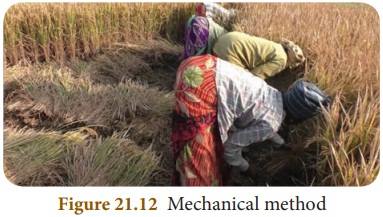
Machine
harvesting
This harvesting method is used in
large sized agriculture fields.
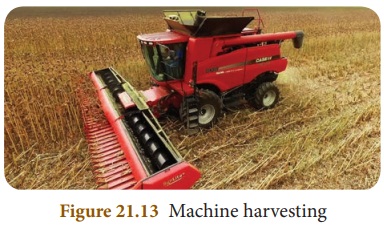
The term harvesting also includes
the immediate post-harvest practices such as threshing and winnowing.
The process of separating the grains
from their chaffs or pods is threshing. After threshing, we must separate the
grains from the chaffs. Winnowing is the process of separating the grains.
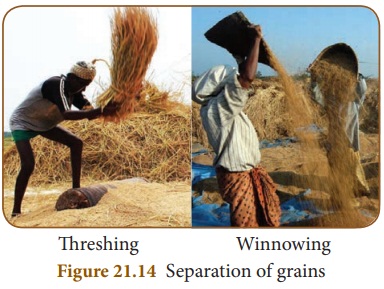
7. Storage of food grains
Storage is an important aspect of
post-harvest technology, because the crop is seasonally produced but consumed
through out the year. Therefore, supply of the produce has to be maintained by
proper storage. Before storing, harvested grains should be made free from
moisture. Any moisture in the stored grins will lead to the growth of
microorganism. So they need to be dried in the sun before storing. Food grains
are collected in gunny bags and then stored in godowns. Silos and grains are used
for the storage of grains on large scale.
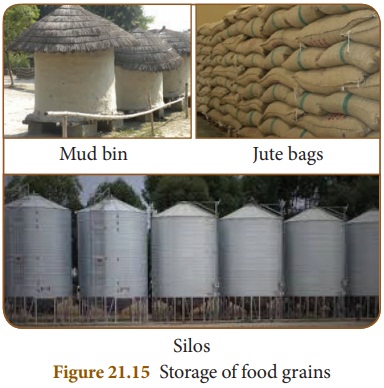
Chemical vapours are sprayed to
minimize pest and insects in godowns. This is called fumigation. The stored grains are inspected from time to time to
make sure that they are free from diseases and pests. In our country, grains
are stored on a large scale in government-owned godowns. The different
categories of agricultural produce needing storage are food grains, oil seeds,
seeds and fodder.
Food Corporation of
India (FCI) was set up on 14th January 1965 at Chennai with the objective of distribution
of food grains throughout the country for Public Distribution System (PDS) and
maintaining a satisfactory level of operational and buffer stocks of food
grains to ensure national food security. Its capital is in New Delhi now.
Activity 4
Visit a food storage
godown in your area and know about the methods followed to preserve the food. Also
discuss in the class room about the importance of preserving and protecting
food grains.
Related Topics